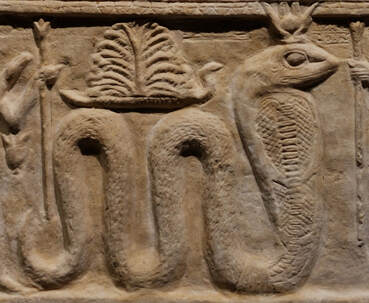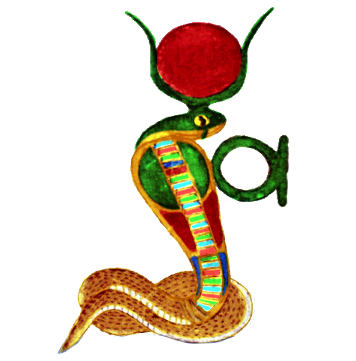Per-Iāret
𓆗𓁥OK 𓆘MK 𓇋𓅱𓂝𓂋𓏏𓆗NK 𓂝𓂋𓂝𓏏𓆗 𓂝𓂋𓏏𓆇𓆚G-R 𓇋𓂝𓂋𓏏𓆗 𓂝𓂝𓂋𓏏𓆗 𓂝𓂋𓏏𓆗
MDC: iart
Gardiner:
Budge:
Alt Egyptian: jꜥrt, Jˁr.t
Demotic:
Transliteration:
Coptic:
Hebrew:
Greek: Ouraeus, Ouraios/οὐραῖος
Arabic:
Latin: Uraeus
English: Uraeus
Kemetic:
Alt: Jaret, Aret, Uaret
IPA:
Pronounced: Ȧārā(t) , Uāre(t)
Meaning: "She who rears up/mount up" - /iar/𓇋𓂝𓂋 "mount up" or /iar/𓇋𓂝𓂋𓊎 ascend, raise up + /t/𓏏 "female ending" ; (or) /iart/𓇋𓂝𓂋𓏏𓆗 "uraeus" (sacred serpent, headdresses of ancient Egyptian deities and sovereigns)
Gardiner:
Budge:
Alt Egyptian: jꜥrt, Jˁr.t
Demotic:
Transliteration:
Coptic:
Hebrew:
Greek: Ouraeus, Ouraios/οὐραῖος
Arabic:
Latin: Uraeus
English: Uraeus
Kemetic:
Alt: Jaret, Aret, Uaret
IPA:
Pronounced: Ȧārā(t) , Uāre(t)
Meaning: "She who rears up/mount up" - /iar/𓇋𓂝𓂋 "mount up" or /iar/𓇋𓂝𓂋𓊎 ascend, raise up + /t/𓏏 "female ending" ; (or) /iart/𓇋𓂝𓂋𓏏𓆗 "uraeus" (sacred serpent, headdresses of ancient Egyptian deities and sovereigns)
Home:
Dynasty: Old Kingdom
Temple:
Nome:
Consort
Children
Parents
Set/Sutekh/Setesh (Father, originally)
Alternative Parentage
Siblings
Female/Male counter part
Priest names
Followers
Features
Snake goddess rearing up, fends off the enemies with her fiery breath
Symbols
Roles
Goddess of death and rebirth, serpent of the pharaoh, protecting him and renewing his life in the Duat (realm of the dead), She also received the deceased king in her evening barque and protected him in his reign in the Duat. She was also symbol of sovereignty, royalty, deity. In the 4th Dynasty She is the one who emerges from Rā and is at the crest of the Re and so the eye of Rā. In the middle Kingdom she became a from of Hut-hor/Hathor in the Duat and fed the deceased. New Kingdom she became a protector goddess of the King and Queen and she gained more power and popularity. In the Greco-Roman period her worship reached it's peek. She was seen as the primordial goddess Niut-hemset.
Interesting facts
Hybrid gods
Connection to other gods
Hut-Hor/Hathor (the mother of Horu/Horus embodiment)
Sopdet (responsible for the flooding of the Nile)
Wadjet (Similar, but Wadjet was placed on head of the deceased, while Iaret was on his forehead causing the nose to breath when reborn.)
Celebrations
Offering items
Protects
Other names
Names derived from the God's name
Epitaphs
Niut-hemset
Dynasty: Old Kingdom
Temple:
Nome:
Consort
Children
Parents
Set/Sutekh/Setesh (Father, originally)
Alternative Parentage
Siblings
Female/Male counter part
Priest names
Followers
Features
Snake goddess rearing up, fends off the enemies with her fiery breath
Symbols
Roles
Goddess of death and rebirth, serpent of the pharaoh, protecting him and renewing his life in the Duat (realm of the dead), She also received the deceased king in her evening barque and protected him in his reign in the Duat. She was also symbol of sovereignty, royalty, deity. In the 4th Dynasty She is the one who emerges from Rā and is at the crest of the Re and so the eye of Rā. In the middle Kingdom she became a from of Hut-hor/Hathor in the Duat and fed the deceased. New Kingdom she became a protector goddess of the King and Queen and she gained more power and popularity. In the Greco-Roman period her worship reached it's peek. She was seen as the primordial goddess Niut-hemset.
Interesting facts
Hybrid gods
Connection to other gods
Hut-Hor/Hathor (the mother of Horu/Horus embodiment)
Sopdet (responsible for the flooding of the Nile)
Wadjet (Similar, but Wadjet was placed on head of the deceased, while Iaret was on his forehead causing the nose to breath when reborn.)
Celebrations
Offering items
Protects
Other names
Names derived from the God's name
Epitaphs
Niut-hemset


